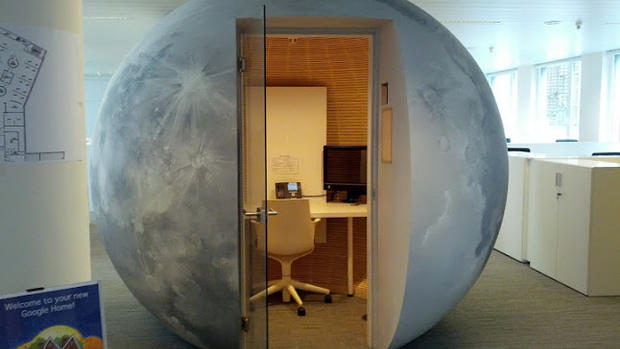Does funky furniture really make people creative?
(MoneyWatch) Does office space really make people collaborative?
James B. Stewart is just the latest in a long line of business writers to be dazzled by Google's offices. Taken on a tour of the lower Manhattan premises, he's agog at the weird and wonderful facilities and benefits. But toward the end of his piece, he dares to ask whether, in fact, this really makes people more productive. The research is pretty thin on the ground. Instead, Harvard's Teresa Amabile says that it's the work itself that prompts (or discourages) collaboration.
When I consider the places where I have done my most creative work, I have to say that their design is not chiefly what I remember. At the BBC, facilities were pretty dull and ugly: Beige, brown and gray. My first job was in an office whose formerly white walls were stained yellow with nicotine. My second one was really a cupboard. But what was great was that we all had our own offices. In theory this should have militated against collaboration, which (if you believe everything you read) needs no more than open space to flourish. But the BBC's long corridors of offices were brilliant: People connected when they wanted to and could work in peace when they didn't. What made us creative was fantastic assignments, brilliant bosses and a profound sense of shared mission. Red wine at lunch -- this was awhile ago -- helped too.
When I think of some of the most creative people I have ever worked with, the setting for their work varied fantastically. One of the best playwrights I worked with used to go to the British Library every day until they turned it into a museum. He was so offended by the new library that he decamped to the local McDonald's -- and his work did not suffer. A terrific software engineer who worked for me mostly worked at night because he loved the silence. J.K. Rowling seems to have done fine in a coffee shop, while one of my production teams opted for a squash court; I never understood how they tolerated the smell.
Don't get me wrong: I think it's terrific to create lively and lovely places for people to work. It says you value them and it says you value good design. These are both important messages. But I've also seen the statutory foosball table, the bright colors, well stocked refrigerators and funky furniture in some of the most poisonous corporate environments in the world, where people would more readily have stabbed each other than share a piece of information.
Moreover, continuous creativity requires constant replenishment. What that means is that you have to leave the office -- however fabulous -- and run the risk of brushing up against the accidental, the contradictory and confusing. Most people will tell you of the great ideas they had when they were driving home from work, looked away from a problem, took a break and played the piano. As Kirby Ferguson so brilliantly argues, much creativity is really just a remix -- but you need a well stocked mind to know what to hurl together. Provocation, dissonance, discontinuity, noise and silence: These are profound ingredients in great creative work because they jolt us out of the safe neural networks we unthinkingly create for ourselves. Designing for them is oxymoronic. I think it's great that Google has fabulous offices and I wish that every company offered workplaces that honored their inhabitants. But most of all I think it's critical -- if you want fresh thinking -- to let people get out.

